Coconut Fiber Plants: Ecology, Economy, and Applications
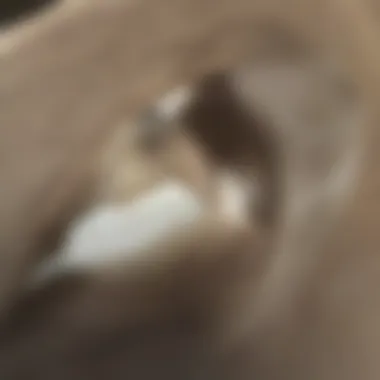

Article Overview
This article aims to provide a systematic examination of coconut fiber plants, often referred to as coir. It delves into a variety of topics, including the biological features of these plants, their ecological roles, and their potential for economic development. By discussing the numerous uses of coconut fiber, along with cultivation practices and environmental benefits, this piece seeks to paint a comprehensive portrait of the subject.
Purpose of the Article
The primary focus is to elucidate the various dimensions of coconut fiber plants. Understanding these aspects is not just academically significant, but also critical for industries relying on sustainable materials. The article intends to embrace an interdisciplinary approach, catering to students, researchers, educators, and professionals who exhibit a keen interest in ecological sustainability and material science.
Relevance to Multiple Disciplines
Coconut fiber plants intersect multiple disciplines, including:
- Botany: Understanding the growth patterns and biological characteristics of coconut plants.
- Ecology: Examining their role in coastal ecosystems and their interaction with other species.
- Economics: Evaluating the market potential of coir products in various industries like textiles and horticulture.
By integrating insights from these fields, the article appeals to a diverse audience and enriches the dialogue around sustainable practices.
Research Background
Historical Context
The significance of coconut fiber has been recognized for centuries. Traditionally, cultures in coastal regions have utilized coir for various applications from ropes to mats. A deeper understanding of its historical usage lays a foundation for recognizing its current and potential applications in modern contexts.
Key Concepts and Definitions
It is crucial to define specific terms related to coconut fiber plants:
- Coir: The fibrous material extracted from the outer husk of coconuts.
- Sustainable materials: Resources utilized in a manner that minimizes environmental impact.
- Biodegradable: Materials that can decompose naturally through the action of microorganisms.
These definitions frame the subsequent analysis of coconut fiber plants, emphasizing their biological, ecological, and economic dimensions and encouraging further exploration in these areas.
"Coconut fiber has emerged as a preferred material in various industries due to its durability and sustainability."
"Coconut fiber has emerged as a preferred material in various industries due to its durability and sustainability."
Thus, the exploration of coconut fiber plants encompasses a mixture of scientific inquiry and practical applications, guiding readers through both theoretical aspects and real-world implications.
Preface to Coconut Fiber Plants
Coconut fiber plants hold a distinctive place in both the ecology and economy of tropical regions. Their multifaceted nature makes them vital for a variety of applications, from sustainable materials to horticulture and even textile industries. This section aims to lay the groundwork for understanding coconut fiber's significance, offering insights into its origins, properties, and relevance today.
Definition and Overview
Coconut fiber, also known as coir, is derived from the coarse fibers found in the outer husk of coconuts. This material exhibits a unique combination of durability and resilience, making it suitable for numerous uses. Coir can be processed into ropes, mats, brushes, and a range of horticultural products.
The fiber itself consists primarily of cellulose, lignin, and pectin, which contribute to its strength and water retention capabilities. As a natural product, it represents an eco-friendly alternative to synthetic materials, appealing to those who prioritize sustainability and environmental health.
Historical Significance
The historical significance of coconut fiber plants can be traced back centuries. Traditionally, these plants have been cultivated in coastal areas, where they play a vital role in the livelihoods of local communities. The use of coir dates back to ancient times, reaching various cultures that have utilized it for practical and ceremonial purposes.
In countries like India, coir was integral in both crafting everyday items and providing protection against coastal erosion. The production methods have evolved over time, but the core principles of utilizing coconut fibers have remained steadfast. As global awareness of sustainable practices has increased, the relevance of coconut fibers has been further emphasized in contemporary discussions surrounding eco-friendly materials.
By presenting the historical context and definition, the importance of coconut fiber plants becomes evident, paving the way for more in-depth exploration of their botanical characteristics and ecological roles.
Botanical Characteristics
Understanding the botanical characteristics of coconut fiber plants is essential for a comprehensive appreciation of their ecological and economic relevance. These plants belong to the genus Cocos, primarily represented by Cocos nucifera, the coconut palm. The study of their classification aids in comprehending their evolutionary traits and biological diversity, which can inform both cultivation practices and conservation strategies.
Taxonomy and Classification
Coconut fiber plants are classified within the family Arecaceae, which includes many palm species. The taxonomy reveals a clear lineage, significant for researchers studying plant genetics and evolution. The genus Cocos has only one readily recognized species, Cocos nucifera, yet several cultivars exist, demonstrating variation in fiber quality and characteristics based on regional adaptations. This classification is not simply academic; it has practical implications in agriculture and industry. Recognizing the different cultivars can lead to better selection for specific purposes, such as fiber production, which is a major economic driver.
Growth Conditions and Habitat
Coconut palms thrive in tropical and subtropical regions, favoring sandy, well-drained soils near coastal areas. They generally require abundant sunlight and warm temperatures, which is critical for optimal fiber production. The plants also exhibit remarkable salt tolerance, allowing them to flourish in various coastal conditions. However, their growth is sensitive to water availability; thus, sufficient rainfall or irrigation is crucial.
Coconut fiber plants are integral to the ecosystems they inhabit. They provide shelter and food for various wildlife, contributing to biodiversity. Their extensive root systems help prevent soil erosion, promoting soil health and stability. This dual role emphasizes their ecological importance, highlighting the need for sustainable cultivation practices that maintain ecological balance.
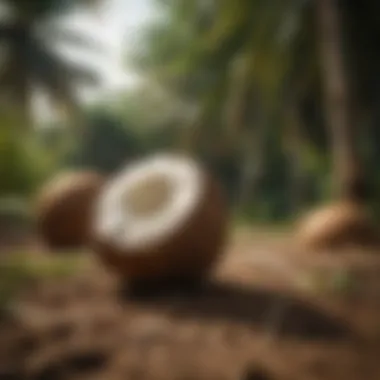
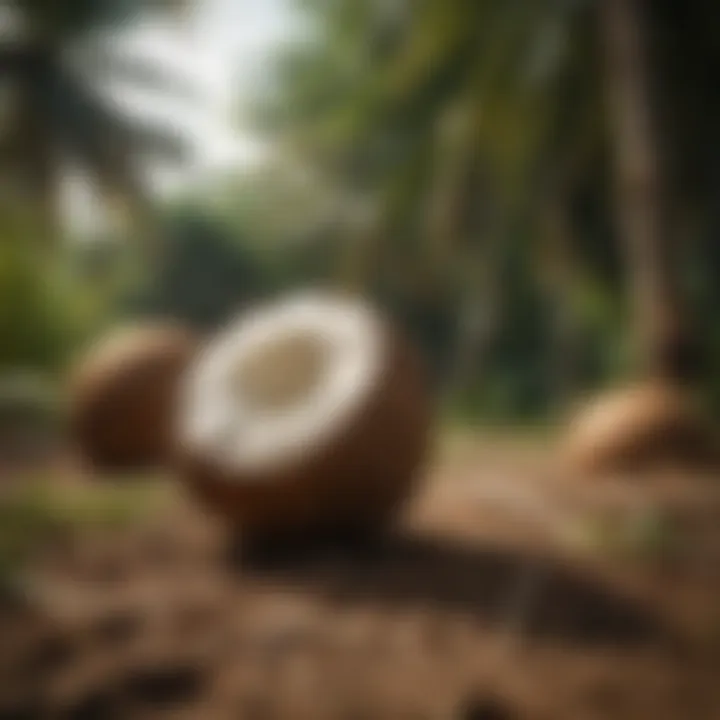
In summary, the botanical characteristics of coconut fiber plants are not only fascinating from an academic standpoint but also vitally important for their application in industry and roles in ecosystems. Understanding these aspects allows for better strategic decisions in both cultivation and conservation.
Coconut Fiber: Composition and Properties
Understanding the composition and properties of coconut fiber is crucial, as it underpins its applications across various sectors. The structure of coconut fiber significantly influences its functionality, making it a subject of interest for scientists and industry professionals. The chemical and physical characteristics will indicate how best to utilize this natural resource, particularly in textiles, horticulture, and sustainable practices.
Chemical Composition
Coconut fiber, known scientifically as coir, is derived from the outer husk of coconuts. Its chemical makeup consists largely of cellulose, hemicellulose, and lignin. The cellulose content in coconut fiber can be about 30-40%, providing rigidity and strength. Hemicellulose, comprising roughly 20-30%, enhances flexibility and contributes to the fiber's resilience. Lignin further adds to the durability, providing resistance against decomposing agents. This combination not only gives coir its structural integrity but also its ability to withstand environmental conditions.
The presence of these compounds makes coconut fiber resistant to saltwater and protects it from microbial damage. For instance, unlike many other natural fibers, coconut does not deteriorate in coastal regions. Its chemical stability makes it ideal for applications in marine environments, such as mats for erosion control and floating grow beds for aquaculture, where both durability and resistance to decay are paramount.
Physical Properties
Coconut fiber possesses several noteworthy physical properties that contribute to its widespread use. First, its tensile strength ranges between 90-200 N, enabling it to bear significant weight without breaking. This strength is important in applications like ropes, where reliability is essential. Furthermore, the fiber's high moisture retention capacity makes it an excellent choice for horticultural purposes. It can hold approximately 8-10 times its weight in water, ensuring that plants receive adequate hydration when used as a growing medium.
Additionally, coconut fiber has a natural insulating property, which can help regulate temperature in planting contexts. This trait is beneficial for promoting healthy root systems in nursery and greenhouse settings. It also has a low density, allowing for easier handling and transport.
"Coconut fiber's unique combination of strength, flexibility, and moisture retention makes it indispensable in various agricultural and industrial applications."
"Coconut fiber's unique combination of strength, flexibility, and moisture retention makes it indispensable in various agricultural and industrial applications."
When discussing its use in textiles, the softness and absorbency of coconut fiber also warrant mention, allowing it to be fashioned into products like eco-friendly mats, brushes, and even upholstery. Its biodegradability is a significant draw for industries seeking sustainable alternatives to synthetic fibers.
In summary, the composition and physical attributes of coconut fiber not only illustrate its versatility but also emphasize its role as a sustainable resource. As industries continue to explore eco-friendly options, understanding these properties will be vital in maximizing the potential of coconut fiber.
Ecological Importance of Coconut Fiber Plants
The ecological importance of coconut fiber plants cannot be overstated. They play a vital role in supporting biodiversity and providing ecosystem services that are crucial for the health of our environment. Understanding these aspects is essential, especially as we confront global challenges related to climate change and habitat loss.
Role in Biodiversity
Coconut fiber plants contribute significantly to biodiversity. They create habitats for various organisms, including insects, birds, and mammals. The fibrous structure of coconut husks offers nesting materials for small wildlife. Furthermore, their presence supports a range of microbial life, which is critical for soil health.
- Diversity of Species: Different coconut varieties can support unique ecosystems, promoting a wider range of flora and fauna.
- Pollinator Support: The flowering coconut palms attract pollinators, which are crucial for the reproduction of many crop species.
- Genetic Resource: Coconut fiber plants can be a source of genetic material for breeding programs, helping in the development of resilient crop varieties.
Ecosystem Services Provided
Coconut fiber plants provide various ecosystem services that are essential for human well-being and environmental sustainability.
- Soil Erosion Prevention: The extensive root systems of coconut trees help hold the soil together, thereby reducing erosion.
- Water Regulation: These plants play a role in maintaining local water cycles. Their presence can enhance water retention in soil.
- Carbon Sequestration: Coconut fiber plants can capture and store carbon dioxide from the atmosphere, thus mitigating the effects of climate change. The capacity for carbon storage is a promising area for further research.
"Coconut fiber plants contribute to ecosystem health by promoting biodiversity and offering indispensable services such as carbon storage and erosion control."
"Coconut fiber plants contribute to ecosystem health by promoting biodiversity and offering indispensable services such as carbon storage and erosion control."
By appreciating and understanding their ecological roles, we can better implement conservation strategies and harness the potential of coconut fiber plants sustainably.
Economic Uses of Coconut Fiber
Coconut fiber, also known as coir, presents a multitude of economic benefits that highlight its significance across various industries. The utilization of coconut fiber extends beyond mere profitability; it supports sustainability while simultaneously addressing the growing demand for eco-friendly materials. Understanding the economic uses of coconut fiber is essential for appreciating its role in contemporary commerce and the environmental landscape.
Textile Industry Applications
Coconut fiber serves as a valuable resource in the textile industry. It is known for its durability and resilience, making it an ideal choice for products such as mats, rugs, and upholstery. Manufacturers often prefer coir over synthetic fibers due to its biodegradable nature and lower environmental impact. Furthermore, the unique texture of coconut fiber gives textiles a distinctive look, appealing to eco-conscious consumers.
Some key benefits include:
- Natural Durability: Coconut fiber products withstand wear and tear better than many synthetics.
- Biodegradability: As a plant-based fiber, coir decomposes naturally, reducing landfill waste issues.
- Versatile Applications: Coir can be blended with other fibers to enhance texture and strength, opening doors to innovative textile designs.
Horticultural Uses
In horticulture, coconut fiber is widely used as a growing medium for plants. Its capacity for water retention makes it a popular substitute for peat. Experts recommend coconut coir for its air porosity, which aids root development and enhances drainage. Using coconut fiber in gardening aligns with sustainable practices, as it encourages the recycling of agricultural by-products.
Some common horticultural applications are:
- Potting Mixes: Coir is often used in potting soils because it retains moisture while preventing overwatering.
- Seed Starting: Its fine texture makes it suitable for starting seeds, providing an optimal environment for germination.
- Mulching: Coconut fiber can be applied as a mulch to help conserve soil moisture and suppress weeds.
Sustainable Material Alternatives
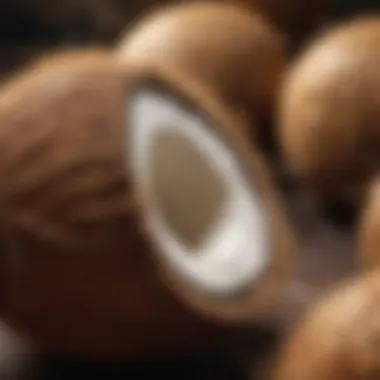
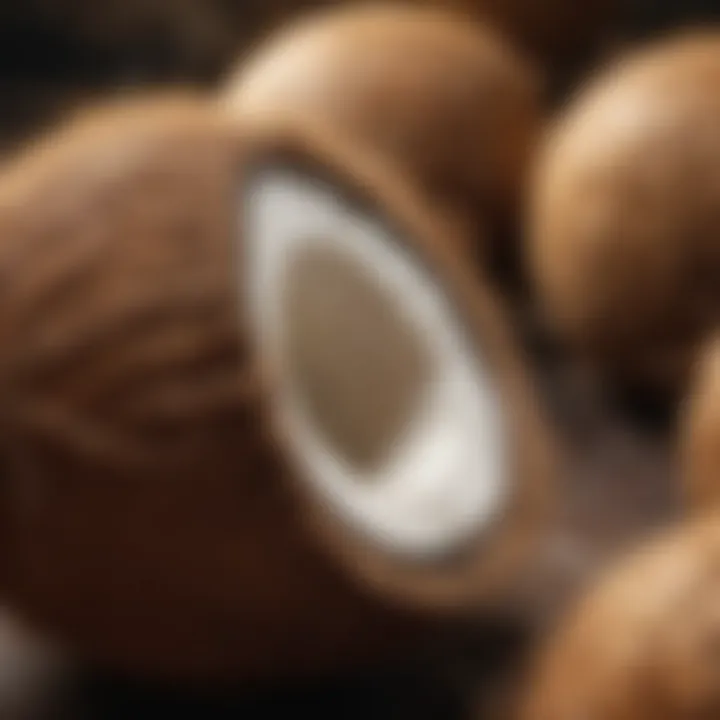
As industries seek sustainable alternatives, coconut fiber emerges as a frontrunner. It offers an eco-friendly option for various products, ranging from biodegradable packaging to insulation materials in construction. The shift towards sustainability has led many companies to explore the integration of coconut fiber into their supply chains.
The advantages include:
- Renewable Resource: Coconut trees grow rapidly, allowing for sustainable harvesting without depleting the environment.
- Carbon Footprint Reduction: Using coir helps reduce reliance on fossil-fuel-based materials, leading to lower carbon emissions.
- Diverse Applications: From automotive interiors to eco-friendly packaging, the potential uses for coconut fiber continue to expand.
"Coconut fiber represents a sustainable shift in how manufacturers view natural materials, aligning with global goals for reducing environmental impact."
"Coconut fiber represents a sustainable shift in how manufacturers view natural materials, aligning with global goals for reducing environmental impact."
The economic dimensions of coconut fiber establish it as a significant player in both traditional and innovative markets. Its versatility not only provides financial gains but also promotes a conscious approach to resource utilization, underscoring its importance in the overall discussion surrounding sustainability.
Cultivation Practices
Cultivation practices play a crucial role in maximizing the yield and quality of coconut fiber plants. These practices are important for several reasons. First, they ensure that the plants grow under optimal conditions, which can significantly enhance fiber production. Second, understanding the needs of coconut fiber plants helps in reducing waste and increasing sustainability. Effective management practices can also lower the susceptibility of plants to diseases and pests.
Planting and Harvesting Techniques
The initial step in coconut fiber cultivation is planting. Selecting the right variety of coconut palms is essential. Specific hybrids may yield more fibers or be better suited to local conditions. The seeds or saplings should be planted in well-draining soil to avoid waterlogging.
Here are some key considerations for planting:
- Spacing: Proper spacing between plants is necessary. This allows adequate airflow and light penetration. A recommended distance is typically around 8 to 10 meters between each palm.
- Depth: Seeds should be planted at a depth of about 30 centimeters. This depth can help facilitate root development.
- Watering: Providing sufficient water is crucial, especially in the early stages. Regular watering drives establishment without allowing for stagnant water, which can lead to root rot.
Harvesting techniques are equally important and involve careful timing. Coconuts should be harvested when they are mature but before they completely dry out. Harsh handling can damage both the fruit and the fibers. After harvesting the coconuts, the fibers are obtained by processing the husks.
Post-Harvest Processing
Post-harvest processing is the stage where raw materials turn into valuable resources. The fibers extracted from the coconut husk must undergo several processes to prepare them for different uses.
- Decorticating: This is the primary step involving separating fibers from the husk. Traditionally, this is done manually or with machines that strip the fibers from the coconut shells.
- Drying: Once extracted, fibers should be dried sufficiently. This reduces the moisture content, thereby preventing mold and decay during storage. The drying process can be done under sunlight for eco-friendliness or using industrial dryers for quicker results.
- Sorting and Grading: After drying, fibers are sorted based on their length and quality. High-quality long fibers are generally more sought after, especially in textile applications. Sorting ensures that manufacturers can provide consistent quality products to consumers.
- Packaging: Finally, the fibers need to be packaged properly. This is essential for maintaining fiber quality during transportation and storage.
Effective post-harvest processing enhances the commercial viability of coconut fiber and contributes to sustainable agricultural practices.
Effective post-harvest processing enhances the commercial viability of coconut fiber and contributes to sustainable agricultural practices.
Through adhering to proper cultivation practices, the full potential of coconut fiber cultivation can be achieved, benefitting both the environment and the economy.
Environmental Benefits
Coconut fiber plants offer a range of environmental benefits that are crucial for both ecosystems and sustainable practices. Understanding these benefits is not only relevant for researchers and professionals in environmental sciences but also encourages informed decisions among industries that utilize coconut fibers. Exploring these advantages contributes to a broader narrative about ecological balance and sustainable development, indicating that coconut fibers are more than raw materials; they are instrumental in fostering a healthier environment.
Sustainability Aspects
The sustainability of coconut fiber plants is linked to their cultivation and lifecycle management. These plants grow in tropical climates and require minimal resources compared to other fiber sources. They thrive in marginal soils, making them an excellent option for agricultural areas that are not suitable for conventional crops.
- Low Water Requirement: Coconut fiber plants are drought-resistant and thus do not demand extensive irrigation.
- Minimal Pesticide Use: These plants are less susceptible to pests, which reduces the need for chemical interventions.
- Waste Reduction: The processing of coconuts utilizes the whole fruit, with fibers being a byproduct that can be reused, supporting a circular economy.
Moreover, the integration of coconut fibers into products reduces reliance on synthetic fibers, which are often derived from petroleum-based sources. This transition is essential for reducing the environmental footprint associated with fiber production.
Carbon Sequestration Potential
Coconut fiber plants also play a significant role in carbon sequestration. The process of carbon sequestration involves capturing and storing atmospheric carbon dioxide, which helps mitigate climate change.
- Growth Cycle: As coconut plants grow, they absorb carbon dioxide from the atmosphere, storing carbon in their biomass. This is especially relevant in an era where climate change poses a serious threat.
- Soil Enrichment: The root systems of coconut plants contribute to soil health, enhancing its ability to store carbon. Healthier soils can sequester more carbon, which has the dual effect of improving agricultural productivity and reducing greenhouse gases.
"By adopting coconut fiber plants in agricultural practices, we can not only yield a valuable material but also contribute to climate change mitigation strategies."
"By adopting coconut fiber plants in agricultural practices, we can not only yield a valuable material but also contribute to climate change mitigation strategies."
In summary, the environmental benefits of coconut fiber plants are multifaceted, encompassing sustainability aspects and significant carbon sequestration potential. As industries seek to align with sustainable practices, the use of coconut fibers could serve as a valuable strategy, aiding in both ecological restoration and economic development.
Challenges in Coconut Fiber Production
The coconut fiber industry has various challenges that producers must navigate to optimize their output and maintain sustainable practices. Understanding these challenges is crucial for any stakeholder involved in the coconut fiber supply chain. This section explores two principal difficulties: market competition and quality control issues.
Market Competition


Coconut fiber production faces significant competition from other natural and synthetic fibers. Materials like jute, hemp, and even polyester can serve similar roles in textiles and horticultural applications. These alternatives often come at lower prices, which can disrupt market dynamics.
The cost-effectiveness of coconut fibers lies in their unique properties, such as durability and biodegradability. However, the initial investment in processing and production can be high. Producers must find ways to communicate the benefits of coconut fibers to consumers and manufacturers. Strategic marketing and education about the environmental benefits can help to create a niche market.
Additionally, the presence of various producers in different geographical regions leads to price fluctuations. For instance, the competition between local manufacturers and imports can impact profit margins. Companies may need to adapt by improving their production efficiency or finding unique selling propositions that highlight the advantages of their coconut fiber products.
Quality Control Issues
Quality control presents another significant challenge in coconut fiber production. The fibers' quality can be affected by numerous factors, such as the age of the coconut, harvesting methods, and post-harvest handling.
Inconsistent quality can result in reduced demand and potential loss of customer trust. For instance, if a batch of coconut fibers is found to be of lower quality, it can lead to higher rejection rates in the textile manufacturing process. Producers need to establish robust quality assurance protocols to mitigate these risks. This includes proper handling during harvesting, thorough sorting, and regular testing of the fibers.
It is also essential to educate farmers about optimal harvesting techniques. Training programs may help to ensure that only mature coconuts are processed, which can enhance the fiber quality. Furthermore, investing in modern processing facilities can assist in maintaining high quality throughout the production cycle.
In summary, while the challenges in coconut fiber production may seem daunting, there are pathways to overcome these hurdles. Addressing market competition and quality control issues effectively can lead to a more sustainable and profitable coconut fiber industry.
Recent Advances in Coconut Fiber Research
Coconut fiber research has evolved significantly in recent years, reflecting the increasing interest in sustainable materials and eco-friendly products. The studies focus on how to optimize the use of coconut fibers and explore their potential benefits across various industries. This section discusses the transformational innovations and the changing landscape in the coconut fiber market, illustrating the pressing need for continued research and development in this space.
Biotechnological Innovations
Recent advances in biotechnology have unlocked new possibilities for coconut fiber utilization. Researchers are investigating genetically modified coconut plants to enhance fiber yield and quality. Techniques such as CRISPR gene editing are being explored to increase resistance to pests and environmental stressors. These innovations not only promise improved productivity but also aim to maintain biodiversity.
In addition, biotechnological methods are used to convert coconut waste into valuable products. For example, enzymatic treatments can modify coconut fiber's properties, making it suitable for unique applications in textiles and composites. This can result in lower production costs and reduced environmental impact.
Emerging Market Trends
The market for coconut fiber is witnessing notable shifts as consumers increasingly prefer sustainable and biodegradable materials. This trend results in an upsurge in demand for coconut-derived products across sectors, including automotive, construction, and padding materials. Given these circumstances, companies are investing in research to improve processing methods and explore new applications.
Moreover, the rise of online platforms has facilitated global access to coconut fiber products. Countries that produce coconut, such as the Philippines and India, are finding new markets and customer bases through e-commerce.
Emerging market trends emphasize the necessity for companies to focus on sustainability and eco-friendliness in product offerings. The shift towards sustainability can enhance brand reputation and attract a more environmentally-conscious consumer base.
Emerging market trends emphasize the necessity for companies to focus on sustainability and eco-friendliness in product offerings. The shift towards sustainability can enhance brand reputation and attract a more environmentally-conscious consumer base.
Future Directions and Research Opportunities
The study of coconut fiber plants presents a fascinating intersection of science and sustainability, and there is considerable potential for future research in this field. As global awareness of environmental issues increases, the interest in natural fibers like coconut has gained traction. This part of the article will highlight areas where advancements can be made to bolster the relevance and effectiveness of coconut fibers in various sectors.
Potential for Genetic Improvements
Genetic improvements hold exceptional promise for enhancing the quality and yield of coconut fiber plants. By employing methods such as selective breeding and biotechnological approaches, researchers can target specific traits for enhancement. This might include increasing the strength and durability of the fibers, improving disease resistance, and optimizing growth rates. Not only does this lead to superior products, but it also enables farmers to cultivate coconuts more efficiently.
Moreover, genetic improvements can contribute to the sustainability of coconut fiber production. By developing more resilient plants, the need for chemical fertilizers and pesticides could potentially decrease. Thus, the ecological footprint of coconut farming would lessen. The implications of such advancements are significant, offering the dual benefits of economic gain for producers and a positive impact on the environment.
Innovative Applications in Various Industries
Coconut fiber has already found applications in diverse industries, but ongoing research can unlock even more innovative uses. For example, in the automotive industry, coconut fiber can be used for sound insulation and as a composite material to reduce weight. This is critical in the pursuit of more fuel-efficient vehicles. Similarly, in construction, utilizing coconut fiber in insulation makes for an eco-friendly alternative to traditional materials.
The beauty industry is also beginning to explore coconut fibers. They can be incorporated into products such as exfoliation scrubs or as biodegradable packaging for cosmetic goods. These applications not only leverage the fiber’s natural properties but also contribute to a reduction in plastic waste.
"The versatility of coconut fiber opens up possibilities that extend well beyond traditional uses."
"The versatility of coconut fiber opens up possibilities that extend well beyond traditional uses."
In summary, the future of coconut fiber research is ripe with opportunities. Enhancements in genetic traits and exploration of innovative applications across industries will continue to position coconut fiber as a key player in sustainable materials. Embracing these research pathways could lead to significant environmental benefits while meeting the rising demand for natural and biodegradable materials in the market.
Closure
The conclusion of this article serves as a crucial component, synthesizing the multifaceted aspects of coconut fiber plants and their broader implications. This section aims to distill the primary insights gathered throughout the exploration and contextualize their importance within both scientific and practical frameworks.
Summary of Key Findings
Coconut fiber exhibits remarkable versatility and utility across numerous sectors. It plays a significant role in the textile industry, offering sustainable alternatives to synthetic fibers. Furthermore, the horticulture applications enhance the growth conditions for various plants, showcasing its potential to improve soil health. The environmental benefits, such as carbon sequestration, further elevate coconut fiber's status as a sustainable resource. The exploration of biotechnological innovations indicates ongoing efforts to enhance fiber quality, thus making it a lucrative market player. Understanding these key findings is paramount for students, researchers, and professionals who seek to leverage coconut fiber in their respective fields.
Implications for Future Research
The implications for future research regarding coconut fiber are equally vital. Given its potential for genetic improvements, researchers can focus on developing resilient strains that offer higher yields and better quality fibers. Innovative applications in various industries, such as construction and automotive, can also be explored to expand the economic footprint of coconut fibers. These research avenues not only contribute to scientific knowledge but also encourage the integration of coconut fiber into sustainable practices. By prioritizing investigations into these areas, the academic community and industries can promote sustainable growth and environmental stewardship.
"Coconut fiber presents an opportunity for sustainable alternatives, pushing boundaries in multiple applications."
"Coconut fiber presents an opportunity for sustainable alternatives, pushing boundaries in multiple applications."
In summary, the conclusion underscores the necessity of ongoing investigation into coconut fiber plants. Addressing the implications and key findings allows for a holistic understanding that can guide future developments, making it essential for all stakeholders involved.



